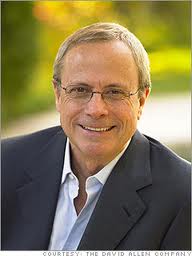Contributor: Liz Stiverson
Work and Life is a two-hour radio program hosted by Stew Friedman, director of the Wharton Work/Life Integration Project, on Sirius XM’s Channel 111, Business Radio Powered by The Wharton School. Every Tuesday at 7 PM EST, Stew speaks with everyday people and the world’s leading experts about creating harmony among work, home, community and the private self (mind, body and spirit).
On Work and Life, Stew Friedman spoke with David Allen, the best-selling author of Getting Things Done: The Art of Stress-Free Productivity and Making It All Work: Winning at the Game of Work and the Business of Life about the five steps in his method to maximize what you accomplish by being focused and present wherever you are, and the habit that can change the culture of productivity in an organization.
The following are edited excerpts of their conversation.
Stew Friedman: You’ve developed and refined a method that helps people to be present in the moment. For the uninitiated, can you give us a brief synopsis of the essence of that method?
David Allen:  The one sentence version is both very simple and practical and pretty sublime. It is: You need to pay appropriate attention to what has your attention; otherwise, it will take more of your attention than it deserves. What has your attention? How many things are on your mind? “I need to get cat food.” “I need to find God.” “I need a career.” “I need to talk to my aunt.” “I need to answer those ten emails.” If you don’t handle those things appropriately, you are inappropriately engaged with your email, with your cat, when you are at work, or with your family. Here’s the big secret: getting things done is not about getting things done. It’s about being appropriately engaged with your life. I figured out the algorithm for being appropriately engaged. There are five steps. First, you have to capture the idea, identify what’s on your mind and record it; do something to get it out of your head. Second, decide what it means to you and what you’re going to do about it. Third, park the results of that decision somewhere you’ll see them at the right time. Fourth, look at the results of those decisions – the things you need to get done – when you need to get them done. And fifth, engage appropriately with doing those things. It isn’t rocket science, but it is something most people haven’t yet truly implemented.
The one sentence version is both very simple and practical and pretty sublime. It is: You need to pay appropriate attention to what has your attention; otherwise, it will take more of your attention than it deserves. What has your attention? How many things are on your mind? “I need to get cat food.” “I need to find God.” “I need a career.” “I need to talk to my aunt.” “I need to answer those ten emails.” If you don’t handle those things appropriately, you are inappropriately engaged with your email, with your cat, when you are at work, or with your family. Here’s the big secret: getting things done is not about getting things done. It’s about being appropriately engaged with your life. I figured out the algorithm for being appropriately engaged. There are five steps. First, you have to capture the idea, identify what’s on your mind and record it; do something to get it out of your head. Second, decide what it means to you and what you’re going to do about it. Third, park the results of that decision somewhere you’ll see them at the right time. Fourth, look at the results of those decisions – the things you need to get done – when you need to get them done. And fifth, engage appropriately with doing those things. It isn’t rocket science, but it is something most people haven’t yet truly implemented.
SF: What do most people struggle with, in your experience?
DA: They try to keep everything in their head. If you’re going to try to go somewhere, you need a map – an orientation tool – and a place to store it. Most people are trying to use their psyche, inside their head as an orientation system, and it’s not designed for that. Your psyche is a terrible map, and a terrible office. Since my first book was published, in the last decade, a lot of neuro- and social scientists have validated a lot of the underlying principles I’ve talked about, including that your head is for having ideas, not for holding them. Evolutionarily, your brain was not designed to remember anything. It was designed to recognize patterns, but not to recall them. Once people get stuff out of their head, they have a much better sense of control and focus about what to do next. Everyone has at some point felt overwhelmed or confused, sat down and made a list, and felt better. Once you reverse engineer that and ask why you felt better without anything actually changing, you’ll never keep anything in your head for the rest of your life.
SF: And it doesn’t matter where you gather the ideas you’ve captured – you’re impartial to the tool as long as there is one.
DA: You can’t beat a pen and paper – that’s my basic collection tool. I carry a notepad in my wallet and tear sheets off for my in-basket, which I can then empty out. I think digital is dangerous for that reason – out of sight, out of mind. The problem with the digital world is that it gives you so many opportunities to put anything anywhere – in files and folders all over the place. You have to keep the collection buckets as simple as possible and empty them as often as possible. Once you’ve gathered the ideas, the next step is to clarify what they mean. Is this something to act on? If it is, what is the action? What outcome are you committed to?
SF: If you have 85 things in your collection place, how do you start?
DA: Pick up one at a time. You can’t prioritize until you’ve been through the whole list – number 84 could be more important than number two, and if you only have ten minutes, your highest priority is to accomplish something that will only take ten minutes. Until you know what all of those 85 things are, you can’t make that judgment. You need your whole inventory.
You have to work at the habit of doing this. For some reason, we don’t seem to be born with these behaviors that seem obvious. People fall off because they have a habit of keeping things in their heads. People also avoid making decisions – someone may write “Buy Mom’s birthday present” and put it in their in-basket, but then pick it up and put it back down over and over saying, “I don’t know what to get her.” You have to decide the next action and make a commitment to what you’ll do. That’s how you get things done, but those questions are not obvious – your brain doesn’t automatically think in terms of outcome and action. “What am I trying to accomplish?” and “How do I move toward that?” are the zeroes and ones of productivity. For companies, for teams, for families, beginning the conversation with “What are we trying to accomplish?” and ending with “What did we decide, what are the next steps, and who’s responsible?” can change a culture.
David Allen has been recognized by Forbes, Fast Company, and Time, and has delivered a TEDx Talk on his method. Hear more from him on Twitter @gtdguy.
Join Work and Life next Tuesday at 7 pm on Sirius XM Channel 111. Visit Work and Life for a full schedule of future guests.
About the Author
Liz Stiverson  received her MBA from The Wharton School in 2014
received her MBA from The Wharton School in 2014
Leave a Reply